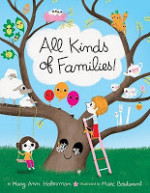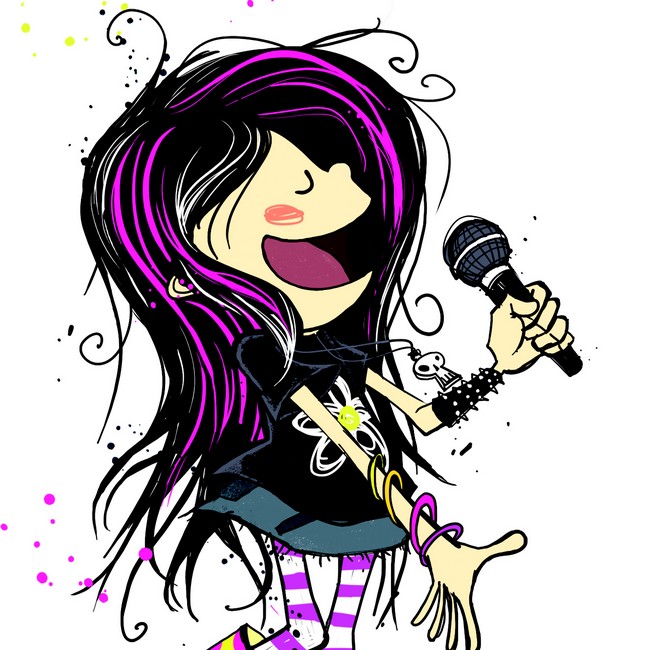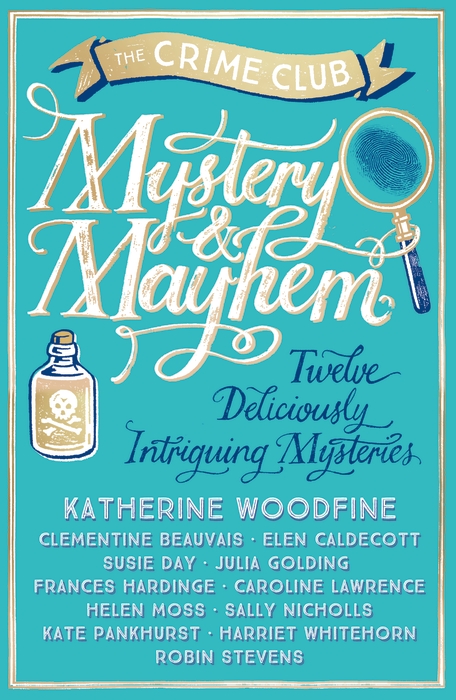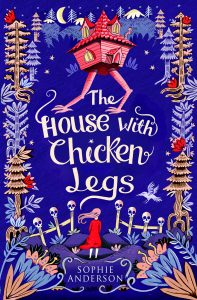
I am a big fan of fairy tale retellings, whether in picturebook form or in novels, and therefore I was intrigued by the idea of Sophie Anderson’s The House with Chicken Legs (Usborne), particularly as I knew very little of Baba Yaga and Slavic fairy tales. It did not disappoint. The House with Chicken Legs tells the story of Marinka, who dreams of a normal life; but when your house has legs and your grandmother is the guardian of the gate to the afterworld ,and you need to help her in supporting spirits as they move to the other side, normal is not really an option. She longs to make her own way into the world, free of the expectations of her destiny, but her house and grandmother have other ideas.
The traditional fairy tale motifs allow Anderson to explore the meaning of grief and accepting oneself in a beautifully lyrical way. Despite the dark themes and setting, she manages to describe the macabre without every being scary or ominous. This is aided beautifully by the artwork in the book by Elisa Paganelli, while the stunning cover is by Melissa Castrillón.
The House with Chicken Legs is a striking début, full of adventure, hope and a wonderful exploration of the importance of cultural heritage.
I am delighted to be part of the blog tour celebrating the release of The House with Chicken Legs, which includes a series of guest posts by Sophie Anderson on Russian fairy-tales. Today, Baby Yaga and kindness:
Fifteen Russian Fairy Tales and What They Mean to Me:
8. Baby Yaga (on kindness)
by Sophie Anderson

‘Once upon a time there lived an old man and his wife …’
In this Russian fairy tale, collected and published by Alexander Afanasyev in 1855, an old man becomes a widower and marries again, but his second wife doesn’t like his daughter.
One day, the father goes away, and the stepmother sends her stepdaughter to the hut of Baba Yaga, to ask for a needle and thread.
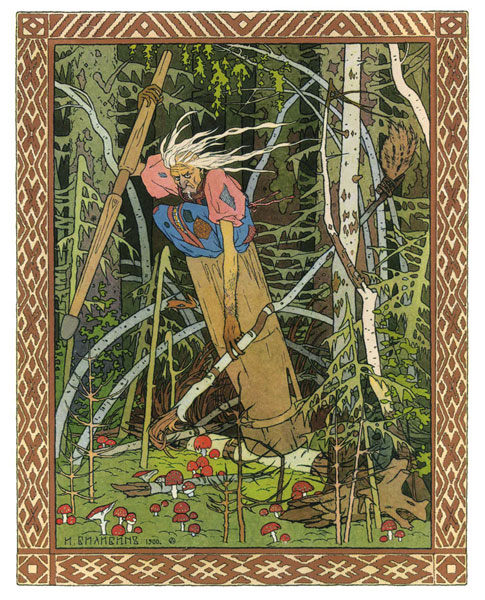
When the stepdaughter arrives, Baba Yaga tells her to sit down and weave while the maid warms her a bath. The stepdaughter knows Baba Yaga is planning to eat her once she has bathed, so she gives the maid a kerchief and pleads with her to prepare the bath slowly. Then the stepdaughter gives a piece of ham to the cat and asks him how she can escape. The cat gives her a comb and a towel and tells her to throw them to the ground if Baba Yaga follows her when she runs away.
The girl takes the gifts and runs. Dogs try to stop her, but she throws them bread; the gates try to bang shut, but she oils their hinges; and a birch tree tries to lash her, but she ties it with a ribbon.
Meanwhile, the cat sits at the loom and weaves so that Baba Yaga doesn’t get suspicious. However, soon enough Baba Yaga notices the girl has fled. Baba Yaga chastises the cat, maid, dogs, gate, and birch but they all retort how the girl was kind to them; giving them ham, a kerchief, bread, and a ribbon.
Baba Yaga jumps into her flying mortar and pursues the girl. But when the girl hears her draw close, she throws down the towel and a river appears, blocking Baba Yaga’s path. But, Baba Yaga returns with oxen who drink up the river, and catches up with the girl once more.
The girl throws down the comb and a forest rises, blocking Baba Yaga’s path again. Baba Yaga tries to gnaw her way through it with her iron teeth, but gives up and returns to her hut.
When the girl arrives home, her father has returned, and on telling him all that has happened the father grows angry and kills the stepmother.
‘“… and then he and his daughter began to live and prosper. I was there and drank mead and beer; it ran down my moustache, but it never got into my mouth.”’
The ending of the tale, where the narrator talks of mead and beer, is a traditional ending to many Russian folktales. It could be reference to how sober the narrator is – thus a testament to the truth of the tale – or a hint that the narrator would like a drink for his efforts.
In this Baba Yaga tale, she is portrayed as pure villain; mistreating her maid and animals, and plotting to eat the young stepdaughter who visits. I always preferred the Baba Yaga tales where she is more of an ambiguous character, but there is some imagery in this tale that I really love; the tying of the lashing birch with a ribbon, the cat weaving at the loom, Baba Yaga giving chase in her flying mortar, and the towel and comb growing into a river and forest.
It is an action packed, thrilling tale, that always has me rooting for the stepdaughter’s escape. And the message in the tale is a simple one about kindness. In fact, some versions of this tale are called Baba Yaga and the Girl with the Kind Heart or Baba Yaga and the Kind Little Girl.
The stepdaughter is kind to the maid, cat, dogs, gate and birch; and as a result, they help her escape. It’s a nice, clear message about the power of kindness; and how if you are kind to others they are likely to show kindness in return. And, more often than not, I think this holds true in real life.
However, the tale also makes me think about the nature of kindness. The girl wanted the maid to prepare the bath slowly; she wanted the cat’s advice; and the dogs, gates, and birch to allow her to escape. So, was the girl only kind to everyone because she wanted, or expected, help in return for her kindness? And if that is the case, is that kindness? Or just clever trading?
Surely true kindness should be altruistic, expecting and demanding nothing in return. My favourite acts of kindness are the selfless ones, the random ones, and the anonymous ones. These make me feel all warm and fuzzy inside and I believe they can be hugely powerful in spreading happiness and compassion.
But would they get you out of Baba Yaga’s hut? Maybe the message is that we need both pure selfless kindness, and a bit of clever trading too!
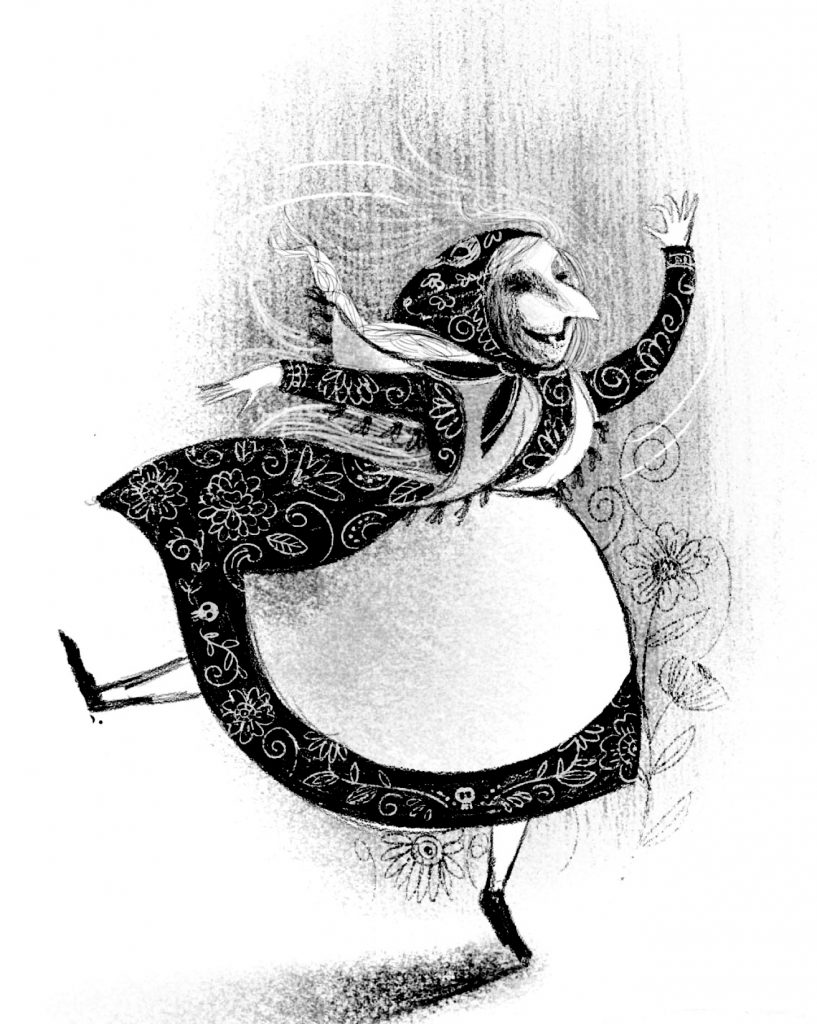
illustration by Elisa Paganelli
A version of Baba Yaga and the Little Girl with the Kind Heart can be found in Old Peter’s Russian Tales, written by Arthur Ransome, published by Puffin.
It also available through Project Gutenberg
***
Many thanks Sophie.
You can follow Sophie Anderson on Twitter, and you can buy The House with Chicken Legs here.
Melissa Castrillón and Elisa Paganelli are also on Twitter.
Check out the rest of the blog tour:





